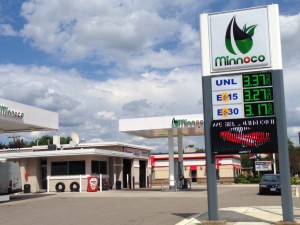EPA-approved E-15 gas drives buyer-beware campaign

By Tom Steward | Watchdog Minnesota Bureau
SHAKOPEE, Minn. — You might log a lot of miles looking for a filling station selling E-15, even three years after the EPA approved the new ethanol blend for use in 2001 and later model and flex-fuel vehicles.
If — not necessarily when — you find one, the nation’s biggest manufacturers and retailers of small engine—powered tools, snowmobiles, ATVs and boats have launched a PR campaign to make sure you to “look before you pump” and potentially make a costly mistake.
“The paradigm by which we have always fueled in this country was whatever went into the car or pickup truck could go in the can. Whatever went in the can went in the generator, the bass boat, the chainsaw and the mower,” said Kris Kiser, president of the Outdoor Power Equipment Institute. “Well that’s different now. For the first time in history, what you put in the car may damage or destroy all of your stuff.”
The EPA requires a warning sticker on the 80 E-15 pumps operating in a dozen mostly Midwestern states, whose farmers grow the corn that produces billions of gallons of ethanol.
“Don’t use in other vehicles, boats, or gasoline-powered equipment. It may cause damage and is prohibited by federal law,” the agency’s label states.
SLOW GOING: Only about 80 filling stations in 12 states sell E-15, including this station in Shakopee, MN.
“No one is saying put E-15 in small engines, and anyone doing that is off base. So there’s people making a big splash about this, but all the pumps are labeled,” said Tim Gerlach, executive director of the Minnesota Corn Growers Association, an ethanol industry advocate. “There are only seven stations in Minnesota. If some people can’t read the pump, I’m not sure they should be driving a boat or using power equipment in their yard.”
Filling stations have long sold E-10, driven by now-expired subsidies and a renewable fuels law that mandates ethanol blending to reduce greenhouse gasses and dependence on foreign oil.
An EPA restriction allowing E-15 sales in summer months to flex-fuel vehicles has complicated the transition. By this fall, however, nearly two dozen independently owned stations will offer E-15.
“It’s not E-85, it’s E-15. It’s another 5 percent,” said Lance Klassen, MSSA executive director who uses E-15 in his wife’s Acura MDX. “Not one complaint. Last week my four retailers said we haven’t had one complaint.”
Yet careless consumers who fill their gas cans or tanks with the wrong blend can damage their outdoor equipment and negate the warranty. Among the biggest group of Minnesota buyers to beware: The state’s 800,000 registered boat owners, second most in the country.
“Higher ethanol blends can corrode metals and rubber and cause engines to break down more quickly,” says Yamaha in a Facebook post for the “Look Before You Pump” campaign. “Also, the higher the ethanol blend, the lower the fuel economy.”
“As a shop, you educate people, but people still run every gas and it doesn’t matter what flavor it is,” said Rob Gleason, service manager at Beeline Sports Center in St. Joseph, a Yamaha dealer. “You tell them they should spend a few more cents and buy this, but they don’t and it makes up a huge part of our business.”
At the same time, ethanol advocates get revved up defending the fuel’s track record, including Bobby Likis, radio host of “Car Clinic.”
“Of the 200,000 engines I’ve serviced, not one has been damaged by ethanol, not one,” says Likis in a Renewable Fuels Association video. “In fact, engines thrive on high-octane, and ethanol has it.”
Still others view “look before you pump” as part of a larger campaign to undermine the renewable fuels standard. The RFS requires an increasing amount of ethanol to be produced and pumped than may be needed, as Americans drive less and get better gas mileage.
“Where do you put all that ethanol to comply with the government mandate? There’s a problem law on the books that we don’t think Congress is going to get resolved, certainly in an election year,” said Kiser of the outdoor power equipment group. “… If folks are going to be confronted with these fuels, we need to do some due diligence.”
The so-called “blend wall” led the EPA to propose reducing ethanol quotas for gasoline this year by more than 1 billion gallons, despite pushback from the biofuels industry.
“Clear policy, clear direction from EPA, Congress and so forth?” said Gerlach of the corn growers association. “When the lobbyists and folks start getting involved, it gets discombobulated. But the fact is more is being used at the same time people might be pushing back against it.”







